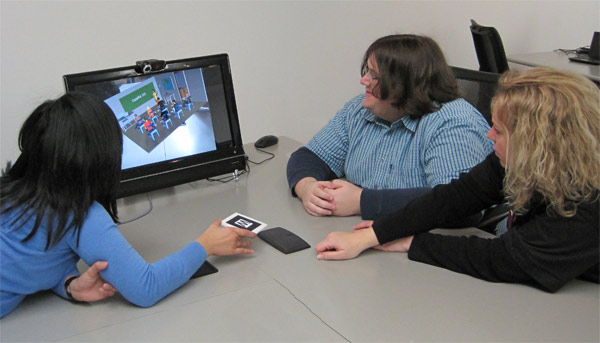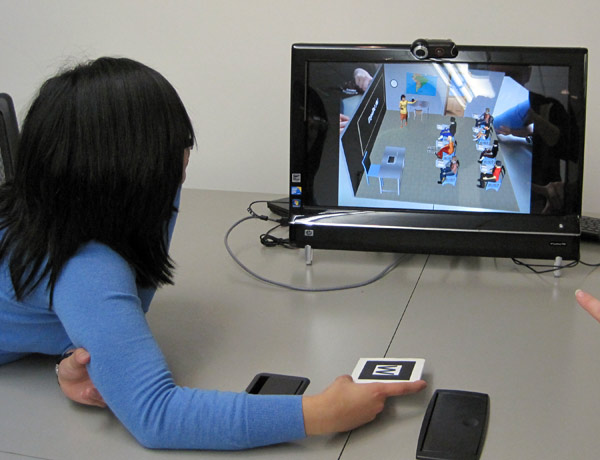In recent months we designed 4 experiments that relate to educational use of Augmented Reality (AR) in language acquisition. Dr. Socorro Zaragoza wanted to experiment with AR in her Spanish 101 class to determine what effects does AR have on student language speaking, writing, reading, listening skills as well as the language comprehension.
Each experiment corresponded to the textbook lesson for SPA 101 and the goal of each experiment was to determine if Augmented Reality influenced student learning. The first lesson/experiment was a typical classroom which contained objects such as blackboard, chair, pen, table, notebook, maps, door, clock, calculator, and book (Figure 1).

Figure 1. Image on the left represents the textbook classroom. The image on the right represents the 3D models developed for the Experiment 1
We designed a replica of the classroom from the textbook in Google SketchUp. Google SketchUp is simple to use and Google 3D marketplace offers myriad of free 3D models that can be imported into the scene you are designing. For example, if you are building a classroom and need a desk, you click on the import models button in SketchUp, search for desk and once you select the one you like, you can import it into SketchUp. Below you can see the video of a complete model used in the class.
Once we had our model of a classroom in a 3DS file, the course instructor decided that this will be a collaborative exercise. Students will be working in groups and be able to freely manipulate the AR markers with their hands. We visited the experimental classroom and loaded each computer with a BuildAR viewer, premade scene (loaded with marker and resized classroom model) and a Logitech 9000 Web cams (6 in total). Figures 2 and 3 and the video below depict the image of a classroom desk with a computer, and loaded AR viewer and student interaction.
Figure 4. Students interacting with the AR model during Spanish 101 class for the purpose of increased vocabulary retention rate.
First AR Experiment – January 24, 2011
Today’s class was about Lesson One: Classroom. It covers words such as blackboard, chair, pen, table, notebook, maps, door, clock, calculator, and book (see Figure 1 above). The procedure of this class was: (1). Pre-test; (2) Lecture; (3) AR activity; and (4) Post-test.
Pre-test: Dr. Zaragoza requested the students to login to the Spanish 101 course shell in Blackboard to take a pre-test of today’s learning materials. The pre-test included five fill-in-the-blank questions that tested students’ understanding of the vocabulary that would be covered in today’s class. Most of the students appeared to be surprised by the pre-test and seemed to be worried. It was not until Dr. Zaragoza told the students that the pre-test was not part of their grade that the students felt relieved. The whole pre-test took around 7 minutes to finish which exceeded what we had planned for. The delay was largely caused by the technology – it took a while for a student to login into Blackboard.
Lecture: Dr. Zaragoza taught the new vocabulary based on lesson one in the textbook. She pointed at the things or objects in the classroom and taught students how to use those words in full sentences. Students took turns to practice the new words as well.
AR activity: After Dr. Zaragoza taught the new words, we started the AR activity. We distributed the AR markers to students and activated the AR viewers for the students. Most of the students did not know what or how to use the marker in the very beginning. Basically, they were sitting there and looked at us setting up the AR viewers for them. As soon as they saw the 3D virtual classroom on the monitor, they appeared to be excited! “Wow, it’s cool” was the most comment we heard from the students. Although some of the students tried to use the markers to see the 3D virtual classroom from different angles or to re-size the 3D virtual classroom, most of the students were not fond of holding the markers to the Web cam. “It kills your hand,” said one girl. At the same time, there were some groups that figured out the easiest way to use the marker was to put it down on the table and re-position the Web cam! (Smart kids!) Even though using the marker seemed to be troublesome to the students, the students were excited by the AR activity and became more engaged with their peers and the instructor. They were pointing at the objects of the 3D classroom, finding the Spanish words for the objects in their textbooks, and practicing the words at the same time.
Post-test: After the AR activity, students took the post-test in Blackboard. The post-test used the same question data set as the pre-test; however, the system randomly generates 5 questions out of 10 questions for the post-test. Compared with the pre-test, students took less time to finish the post-test. In merely two minutes, two of the students finished the post-test. Bravo!
Download source files here (SPA 101 3D classroom files, AR marker and marker PDF file). Once you download the file, unzip all contents and read “instructions.txt file”. We posted a brief instructional video on how to open up a scene on YouTube: http://www.youtube.com/watch?v=f3C97PPTinE



3 Responses to AR & Language Acquisition (Spa 101) Part 1